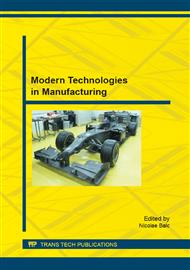p.119
p.125
p.131
p.137
p.143
p.149
p.155
p.161
p.169
Mold Design for Polystyrene Plastic Anchor
Abstract:
The paper presents the entire process of designing and optimizing an injection mold for a polystyrene plastic anchor. The design process begins with a comprehensive market study of the polystyrene plastic anchors available on the Romanian market, and the results of this study are then used for the creation of a new model of anchor. After this first stage of design, the resulted model is optimized in terms of the injection process using the simulation software Autodesk Moldflow Adviser. After establishing the final form of the polystyrene plastic anchor, the mold is designed in Catia V5 using a series of standardized components. Manufacturing set-up is done in Catia V5 and Cimatron. In the end, the validation of the mold is performed using the injection machine Haitian Mars 2-2500.
Info:
Periodical:
Pages:
143-148
Citation:
Online since:
November 2015
Authors:
Keywords:
Price:
Сopyright:
© 2015 Trans Tech Publications Ltd. All Rights Reserved
Share:
Citation:


